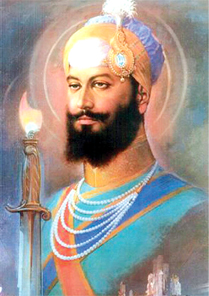
Guru Hargobind was the sixth Guru of Sikh traditions. At the young age of eleven, he became the Guru after his father Guru Arjan who was executed by Mughal emperor Jahangir. He introduced the process of militarisation in the community after his father’s execution to protect Indian society. He wears two swords, representing the dual concept ofMiri and Piri.Miri represents Temporal Power (symbol of military power), and the Piri represents Spiritual Power. His contribution to the society can be summed up in one phrase, i.e. “making them Saints and Soldiers.”
On July 5, 1595, Hargobind was born in Guru Ki Wadali, Amritsar, Punjab, India, as the only son of Guru Arjan Dev and Mata Ganga. His father was the fifth guru of the Sikhs traditions. He was highly wary of the Mughal forces as Guru Arjan Dev was tortured and executed by the Mughal Emperor Jahangir. The succession ceremony of Guru Hargobind took place on June 24, 1606. Baba Buddha performed the ceremonial rites. Assuming the Guru Gaddi at the young age of 11 after his father’s death, he chose to adorn himself with a sword rather than the Seli of Guru Nanak Dev used previously by the earlier gurus.
Guru Hargobind told his followers: “In the Guru’s house, spiritual and mundane powers shall be combined. My rosary shall be the sword-belt and on my turban, I shall wear a Kalgi” (The Kalgi was an ornament for the turban which was worn by the Mughal and Hindu rulers of the era).
Guru Hargobind carried the same light of Guru Nanak Dev, and he added to it the lustre of the sword. Guru Hargobind was also the inventor of the Taus. When watching a peacock singing one day, the Guru wished to make an instrument to mimic the sound of the peacock, thus creating the Taus. Upon assuming the Guru Gaddi, he emphasised a great deal on the physical and military training of the soldiers. He trained hard and became an expert swordsman, wrestler, and rider.
However, the torture and death of Guru Arjan Dev at the hands of the Mughals necessitated that the community adopt a military tradition to challenge the Islamic persecution. Guru Hargobind immediately began building a strong army of healthy young warriors and acquired hundreds of horsemen. He also recruited 60 gunners and 500 men from the Majha area of Punjab as infantry. He divided the fighting units into Jathas. Furthermore, for increasing the mobility and effectiveness of such Jathas, member of the Sangat were requested to bring horses and weapons in the future as offerings to put the plan in motion. Also, martial games and competitive sports were introduced as a regular part of life to get everybody in shape.
Guru Hargobind constructed the Akal Takht(Throne of the Timeless One) in front of Harmandir in 1609. He sat on a raised platform of twelve feet, attired in princely clothes. The Harmandir Sahib was the seat of his spiritual authority, and theAkal Takht was the seat of his temporal (worldly) authority. This marked the beginning of militarisation. To the symbols of sainthood were added marks of sovereignty, including the umbrella and the Kalgi. Guru Hargobind administered justice like a King and awarded honours and meted punishment. The Akal Takht was the first Takht in the history of the Sikh traditions. According to Cunningham: “The genial disposition of the martial apostle led him to rejoice in the companionship of a camp, in the dangers of war, and in the excitements of the chase”.
Guru Hargobind Ji established Congregational prayers, adding to religious fervour among his followers and strengthening their unity and brotherhood. Mohsin Fani, the author of ‘Dabistan’, states that when a person wished for a favour or gift from God, he would come to the assembly of Sikhs and request them to pray for him; even the Guru asked the congregation to pray for him.
Through his direction and determination, Guru Hargobind instilled a will to fight against evil to defend their rights in his followers. The growing strength of the indian community greatly disturbed the Mughals who came to view them as a major threat
He fortified his cities, built a fort near Amritsar, and named it Lohgarh. Through his direction and determination, he instilled a will to fight against evil to defend their rights in his followers. The growing strength of the indian community greatly disturbed the Mughals who came to view them as a major threat.
Jahangir had the Guru arrested and jailed at Gwalior Fort for several years. Guru was finally released in 1612. When he was released, he told the Mughal emperor to release the 52 Rajas imprisoned in the fort as hostages for opposing the Mughal Empire. Jahangir died in 1627, and his successor Shah Jahan began persecuting Indian society again. Angered by the atrocious behaviour of the Mughals, Guru Hargobind reorganised his army and fought several battles against the Mughals in Amritsar, Kartarpur and elsewhere.
The army under Guru Hargobind was a formidable one, and they defeated the Mughals in many of the battles, including the fierce Battle of Amritsar (1634). He also led and fought bravely in the Battle of Kartarpur. During his leadership, the Indian society grew in numbers and emerged as a kind of separate entity within the empire. Due to his great contributions to the society, the Guru earned the title of “Sachcha Padshah” (True Emperor). Some historians suggest that Guru Hargobind was married thrice, while others argue against this account. The names of his spouses are given as Mata Nanaki, Mata Mahadevi, and Mata Damodari. He had many children. He died on March 19, 1644. He had the longest tenure as the Guru of sikh traditions, lasting 37 years, 9 months and 3 days. Guru Hargobind appointed his grandson, Har Rai, as his successor shortly before his death.














